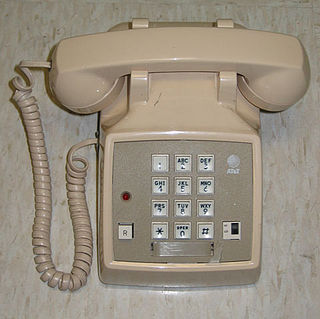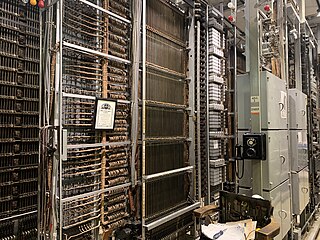Related Research Articles

Dual-tone multi-frequency signaling (DTMF) is a telecommunication signaling system using the voice-frequency band over telephone lines between telephone equipment and other communications devices and switching centers. DTMF was first developed in the Bell System in the United States, and became known under the trademark Touch-Tone for use in push-button telephones supplied to telephone customers, starting in 1963. DTMF is standardized as ITU-T Recommendation Q.23. It is also known in the UK as MF4.

A telephone switchboard was a device used to connect circuits of telephones to establish telephone calls between users or other switchboards, throughout the 20th century. The switchboard was an essential component of a manual telephone exchange, and was operated by switchboard operators who used electrical cords or switches to establish the connections.
In telephony, on-hook and off-hook are two states of a communication circuit. On subscriber telephones the states are produced by placing the handset onto or off the hookswitch. Placing the circuit into the off-hook state is also called seizing the line. Off-hook originally referred to the condition that prevailed when telephones had a separate earpiece (receiver), which hung from its switchhook until the user initiated a telephone call by removing it. When off hook the weight of the receiver no longer depresses the spring-loaded switchhook, thereby connecting the instrument to the telephone line.
In telephony, ringdown is a method of signaling an operator in which telephone ringing current is sent over the line to operate a lamp or cause the operation of a self-locking relay known as a drop.
In telecommunication, signaling is the use of signals for controlling communications. This may constitute an information exchange concerning the establishment and control of a telecommunication circuit and the management of the network.
Telephony is the field of technology involving the development, application, and deployment of telecommunication services for the purpose of electronic transmission of voice, fax, or data, between distant parties. The history of telephony is intimately linked to the invention and development of the telephone.

A blue box is an electronic device that produces tones used to generate the in-band signaling tones formerly used within the North American long-distance telephone network to send line status and called number information over voice circuits. This allowed the user, referred to as a "phreaker", to surreptitiously place long-distance calls that would be billed to another number or dismissed entirely as an incomplete call. A number of similar "color boxes" were also created to control other aspects of the phone network.

A telephone call is a connection over a telephone network between the called party and the calling party.
In telephony, multi-frequency signaling (MF) is a type of signaling that was introduced by the Bell System after World War II. It uses a combination of audible tones for address transport and supervision signaling on trunk lines between central offices. The signaling is sent in-band over the same channel as the bearer channel used for voice traffic.
The ISDN User Part or ISUP is part of Signaling System No. 7 (SS7), which is used to set up telephone calls in the public switched telephone network (PSTN). It is specified by the ITU-T as part of the Q.76x series.

E and M signaling is a type of supervisory line signaling that uses DC signals on separate leads, called the "E" lead and "M" lead, traditionally used in the telecommunications industry between telephone switches. Various mnemonic names have been used to memorize these letters, such as Ear and Mouth, the most common variation.

On analog telephone lines with special services, a flash or register-recall signal is used to control functions on the public telephone exchange, PBX or VoIP ATA.
In telephony, a special information tone (SIT) is an in-band international standard call progress tone consisting of three rising tones indicating a call has failed. It usually precedes a recorded announcement describing the problem.
Line signaling is a class of telecommunications signaling protocols. Line signaling is responsible for off-hook, ringing signal, answer, ground start, on-hook unidirectional supervision messaging in each direction from calling party to called party and vice versa. After an off-hook, line signaling initiates register signaling to accomplish the exchange of telephone numbers of called party and in more modern line-signaling protocols, the calling party as well. While register signaling occurs, line signaling remains quiescent unless the calling party goes on-hook or an abnormal cessation of the call occurs, such as due to equipment malfunction or shutdown or due to network outage upstream in that call-attempt's series of spanned trunks.
Loop start is a telecommunications supervisory protocol between a central office or private branch exchange (PBX) and a subscriber telephone or other terminal for the purpose of starting and terminating a telephone call. It is the simplest of the telephone signaling systems, and uses the presence or absence of loop current to indicate the off-hook and on-hook loop states, respectively. It is used primarily for subscriber line signaling. An extension of the protocol that adds disconnect supervision is often called kewlstart.
In telephony, ground start is a method of signaling from a terminal of a subscriber local loop to a telephone exchange, where one side of a cable pair is temporarily grounded to request dial tone. Most middle 20th-century American payphones used coin-first ground start lines, with the starting ground connection provided by the coin itself, bridging a set of contacts as it passes through the coin chute.
Foreign exchange service (FX) is an access service in a telecommunications network in which a telephone in a given exchange area is connected, via a private line, as opposed to a switched line, to a telephone exchange or central office in another exchange area, called the foreign exchange, rather than the local exchange area where the subscriber station equipment is located.
Ringing is a telecommunication signal that causes a bell or other device to alert a telephone subscriber to an incoming telephone call. Historically, this entailed sending a high-voltage alternating current over the telephone line to a customer station which contained an electromagnetic bell. It is therefore also commonly referred to as power ringing, to distinguish it from another signal, audible ringing, or ringing tone, which is sent to the originating caller to indicate that the destination telephone is in fact ringing.

A telephone exchange, telephone switch, or central office is a telecommunications system used in the public switched telephone network (PSTN) or in large enterprises. It interconnects telephone subscriber lines or virtual circuits of digital systems to establish telephone calls between subscribers.

The Panel Machine Switching System is a type of automatic telephone exchange for urban service that was used in the Bell System in the United States for seven decades. The first semi-mechanical types of this design were installed in 1915 in Newark, New Jersey, and the last were retired in the same city in 1983.
References
- ↑ Bell Laboratories Technical Staff, Telecommunication Transmission Engineering, Vol. 1, 2ed, Salem, NC (1977) p.321.
- ↑ US government glossary
- ↑ "Voice Network Signaling and Control". Cisco Systems. 2008-12-04. Retrieved 2013-07-26.
- ↑ Phillip P. Daniele, US Patent No. 4,158,755,Telephone system open switching interval protection circuit (1979)
- ↑ RFC 3660, Basic Media Gateway Control Protocol (MGCP) Packages, B. Foster, F. Andreasen (2003)